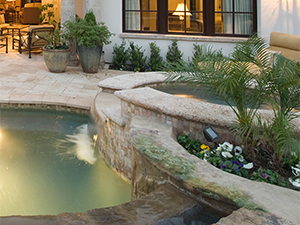
Why Pool Decks Turn Green and Black
What is that green and black stuff growing on my pool deck? This is a question pool owners often ask. This article will help you identify and remove pool deck discoloration, as well as minimize the likelihood of future discoloration.
Biological Growth Types
The majority of unsightly green and black spots on pool decks are the result of biological growths in the form of algae, molds, lichens and mosses, and plants such as ivy and grasses. Let’s take a look at each:
- Algae is commonly green in color but can also be black, orange, red or yellow. It is easy to identify since it grows in mats, films, and patches on the surface of stone, brick and concrete. Algae is a single-cell plant but lacks roots, leaves, stems and vascular tissue. Most algae, especially the green type, needs moisture and sunlight to grow. However, there are species that will grow in damp, low-light areas.
- Moss is most commonly green but can also be red. Like algae, it requires sunlight and moisture to grow. It also needs a mineral source often found in soils. Unlike algae, moss has a root structure and a very small leaf structure. It will often grow in grout between stone and masonry.
- Mold is a fungus, not a plant. It does not require sunlight but does require moisture and an organic food source. Mold is generally black in color but can also be red, orange, brown, or yellow. Limestone is especially susceptible to mold growth, since it contains organic matter that can feed mold.
- Lichens are comprised of a fungus living in a symbiotic relationship with an algae or a relative of bacteria called cyanobacterium (or both in some instances). They can be red, yellow, red, green, or white. Lichens are identified by crusts or leaf-like structures with defined borders growing away from the surface of the stone or masonry.
- Ivy, grasses, and higher plants are easily identified by their root systems and large leaf structures. They are often green in color.
Removal of Biological Growth
Regardless of the type of biological growth, removal requires the use of biocide cleaning chemicals, such as peroxide, bleach, or other biocides. Here is a basic cleaning procedure that is recommended to remove these growths. Be sure to carefully read the directions on chemicals and take all necessary precautions. Wear gloves and protective clothing. A mask is recommended, since some mold and algae can emit spores that can be harmful to your respiratory system.
Algae is best removed when it is dry since the spores are more likely to become airborne when wet. Allow the surface to fully dry, or expedite the drying process with a fan. Remove as much algae as possible by scraping or scrubbing with a stiff broom or brush.
A pressure washer can be used to remove the remaining biological growth, but there are a few additional precautions and recommendations:
- Do not use high pressure. Test the pressure in a non-conspicuous area to make sure you are not damaging the stone or masonry.
- Use hot water, if possible. Hot water will kill some of the biological growth and sanitize the surface.
- Use a wide nozzle tip to minimize damage. Keep the tip of the wand at least 12 inches away from the surface.
- Bleach or vinegar can be used to clean stubborn growth. Mix the bleach or vinegar. Use one cup of bleach or vinegar with one gallon of water. Test this mixture in a non-conspicuous area to see if it will cause discoloration. Some stone and masonry types can lighten, discolor, or etch with bleach or vinegar.
- Apply the bleach or vinegar mixture on the deck and allow it to sit for 15-20 minutes. Do not let it dry. (If it accidentally dries, apply more of this mixture.)
- Scrub the area with a nylon brush. Rinse with plenty of clean water. Be careful to avoid nearby plants, since this mixture can kill landscaping plants and grasses.
In lieu of bleach or vinegar, you can use many of the commercial cleaners appropriate for your pool deck surface type. You can find them at most home centers. If your pool deck is natural stone, be sure to use a pH-neutral, stone-safe cleaner. Read the directions carefully.
Spot Removal
If you have just a few spots, you can use 3% hydrogen peroxide. Simply spray the growth with the peroxide, allow it to sit for several minutes, and then rinse with water.
Prevention
Your best defense to keep biological growth at bay is to clean the deck on a regular basis. We can professionally clean your pool deck for the best results. We can also apply sealers and preventive biocides to inhibit new growth.
We can provide specific recommendations regarding cleaners for green and black growth on your pool deck. If you have questions about identifying and removing pool deck discoloration and preventing growth or would like to schedule services, contact us.
This article is one of a series of articles written and published on behalf of Surface Care PRO Partners.



